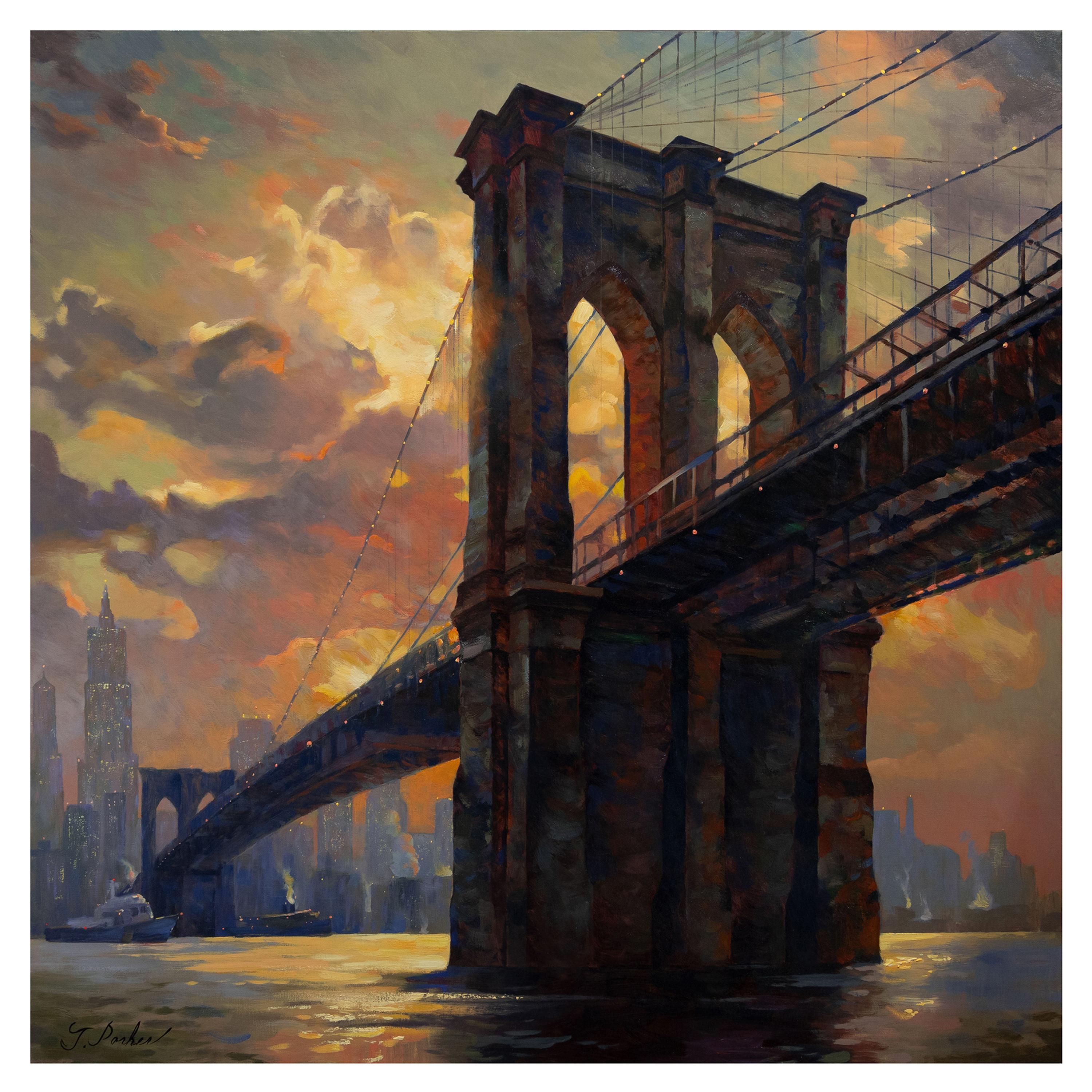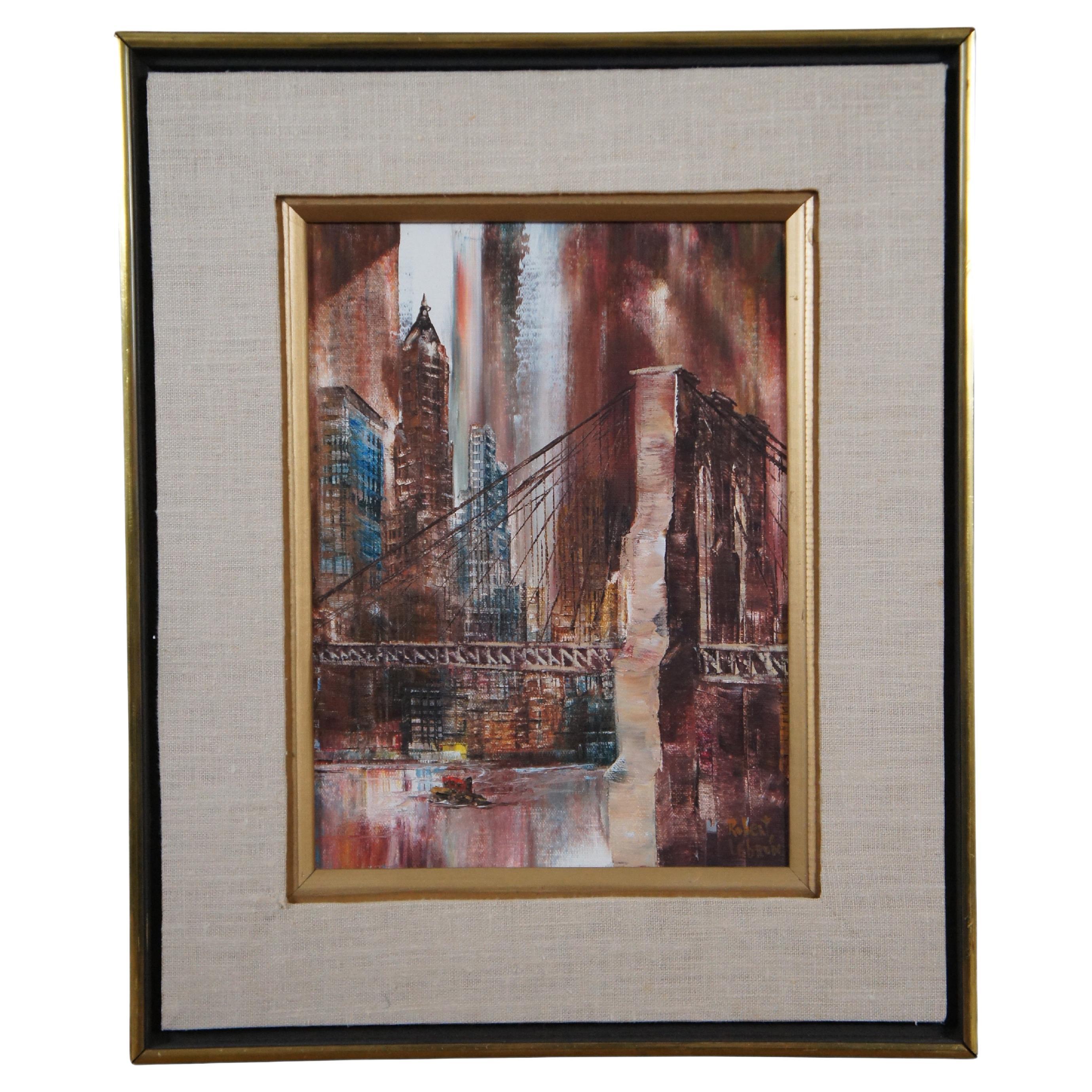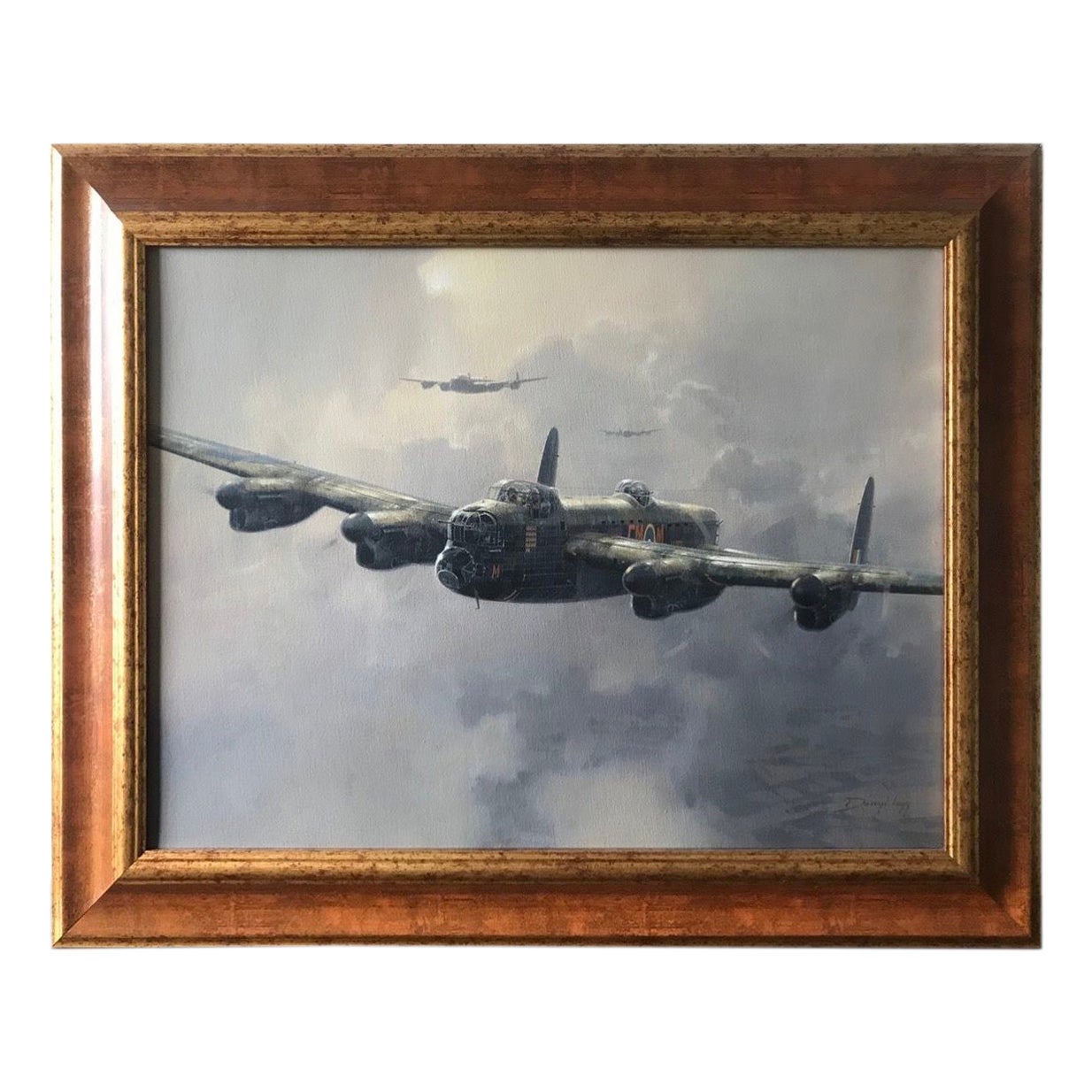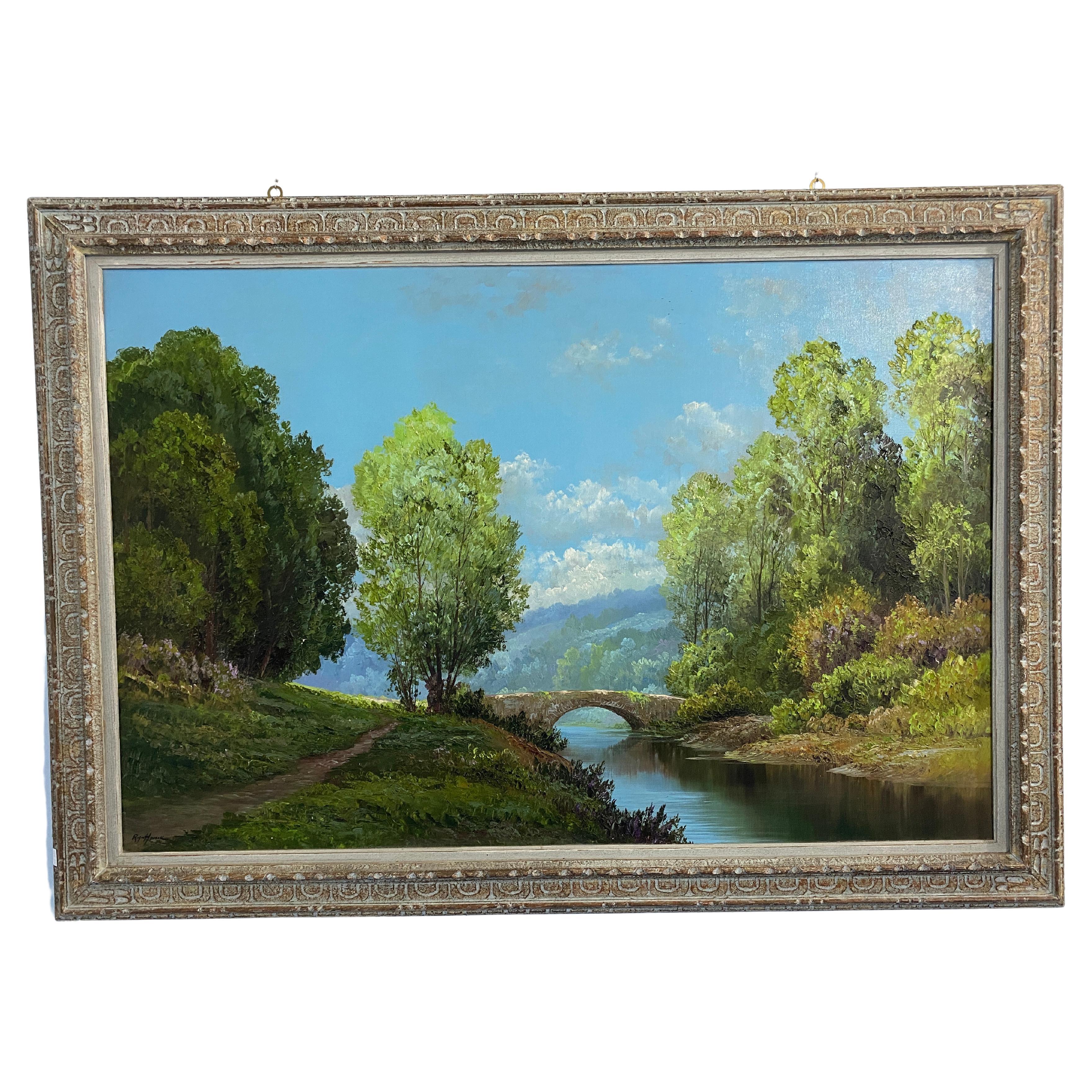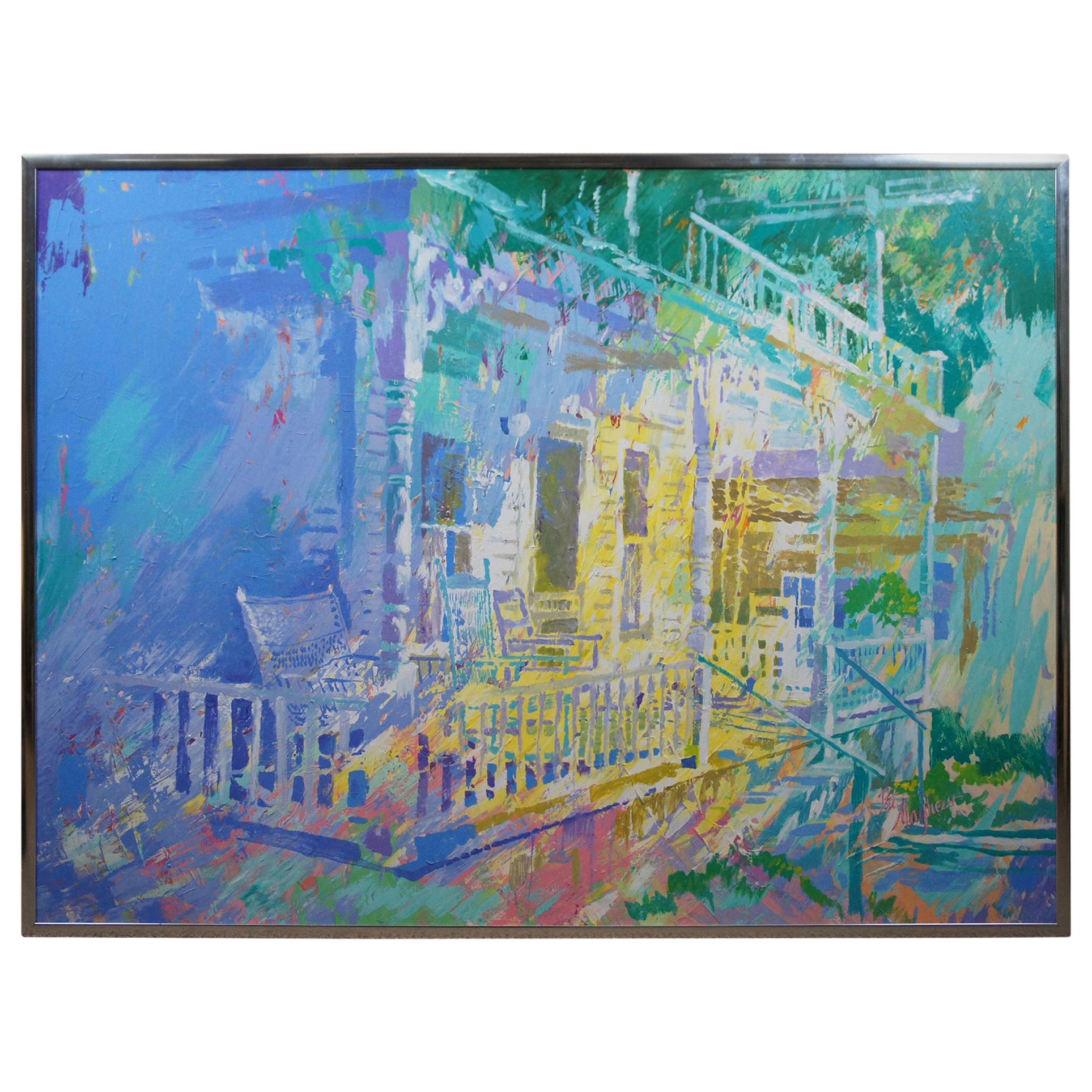Items Similar to Lancaster Bridge Original Oil Painting
Want more images or videos?
Request additional images or videos from the seller
1 of 12
Lancaster Bridge Original Oil Painting
About the Item
A very interesting and unusual Lancaster Bridge Original Oil Painting by artist J. Earle Pfoutz. The painting is produced on artist board and comes complete with what appears to be an original artist decorated/painted frame. The painting is signed on the front by the artist.
Overall frame Size approximately 42″ wide x 2″ deep x 30″ high
J. Earle Pfoutz had a long and distinguished career as a self trained artist. More can be learned about him from reading this article produced by Gary Hawbaker at askART
Earle Pfoutz Born: 1891 – Lancaster, Pennsylvania
Died: 1957
Known for: Landscape, figure, still life painting
An image of J Earle Pfoutz
Biography from the Archives of askART
J. Earle Pfoutz (John Earle Pfoutz) – (Oct 23, 1891-Nov 9, 1957)
“A seventh generation descendant of a Swiss family which arrived in America early in the 17th Century, J. Earle Pfoutz was born in Lancaster, PA, son of John Bachman and Susan Allison Pfoutz. He painted houses for a living and pictures for a life.
A self-taught artist, described as a primitive, he was distinctive for his vivid imagination and bold color application. He painted hundreds of Lancaster County scenes. Pfoutz traveled through the hills near his home and along the Susquehanna River in search of scenes. He began painting with a brush when he was fourteen, but added a palette knife after suffering an eye injury. He completed eighth grade in the Lancaster Public Schools and there his formal education ended. However, the Department of Public Instruction of the State of Pennsylvania thought so highly of his work as an artist that officials certified him as an art instructor and he taught for a year in the York (PA) public schools. He also was an art instructor under the program for disabled veterans, sponsored by the Veterans Administration, when he gave private instruction to veterans in their homes.
In 1947, J. Earle Pfoutz finally earned national recognition as an artist. His painting, Opalescent October, was chosen by the Museum of Art of Dayton Ohio, to travel all over the country for a year with its Group Exhibition. Described as a “very colorful, calm scene, iridescent in color, sweeping in design,” the painting started on its journey around the country early in 1948. In an interview with the Sunday News (Lancaster, PA – Nov 2, 1947), Pfoutz stated that he didn’t know whether he was a “primitive” or an “impressionist.” No master taught him, no school channeled his style. “Sometimes I didn’t eat, but I always managed to paint,” he recalled. Many of his hundreds of canvases -most of them not sold, but given away to friends – found their way to other parts of the country. “I never remember the day when I did not love color,” Pfoutz said. “I was about 12 years old when I saw my first palette – a string of different colored paint paddles that graced the stores of that day. As a boy I had two great desires. One was to be able to eat all the strawberry jam I could, and the other to possess a string of those beautiful paint paddles. Well, I’ve got my fill of jelly, but I’ve never yet got my fill of beautiful colors.”
In 1950, Pfoutz’s one man show of paintings made front page headlines in the Lancaster Intelligencer Journal: “Most of the twenty oil paintings on exhibition are landscapes, although there are several interesting figure studies. Colors again, as in all Pfoutziana are rich and full-bodied, but for the most part not as startlingly as in some of the earlier work. Most of the paintings were done during the past year, and also reveal the painter’s characteristic heavy impasto technique, in which the rich swirls of paint carry their own message. Among the figures, The Banjo Picker, and The Magician, are the most provocative. Both are character studies; the first being of a tramp musician whose drab clothing is set-off by a luminous aqua blue background. Modern in feeling and treatment is The Magician, a clown-faced wizard whose spinning ball in the air suggests the fourth dimension – space. The use of the primary colors in this picture serves to emphasize the theme effectively.
A large colorful landscape, Opalescent October, depicting rolling hills against a late afternoon sky is new to Lancastrians, as it has just returned from Dayton, Ohio, where it hung in the Dayton Art Institute. Another landscape with soft dreamy colors is Fantasie D’Autumne, and one of the loveliest pictures in the show. Pennsylvania Dutch Country is another with eye appeal, and was one of the works which was hung in the Old Customs House in Philadelphia during Pennsylvania Week, and before that in a collection of Pfoutz work in the same place. In deep contrast to the sunny skies and brilliant foliage of many of the pictures, is the somewhat morbid Worry, in which the center of interest is a tremendous rat. This, the painter explains, was symbolic of 1948 in China, which was ‘The Year of The Rat’ in the Chinese calendar. Background material for the picture was furnished to Pfoutz by author Pearl Buck.
Other pictures include Autumn Prelude, Miners Village, painted at Cornwall, PA; Humid Day, Saint Peters Kierch, at Middletown, PA; Lady Pfoutz, inspired by the painter’s wife; Sun Flowers, Sentimental Journey, Gyne, Luzon Woman, Old Bridge, The Cow Path. Lemures, based on Roman mythology, and Ethiopian, painted from an ebony wood carving from Kenya Province, S. Africa.”
In 1953, Pfoutz was installed as President of the Lancaster County Art Association. A. Z. Kruse, New York City artist, writer and member of the faculty of the Brooklyn College and the Cartoonists and Illustrators School, Manhattan, was the guest speaker. In January of 1953, thirty-five Pfoutz oils were exhibited at the Old Custom House in Philadelphia, PA under the sponsorship of the Carl Schurz Memorial Foundation. Several Lancaster County landscapes and covered bridges were included as well as Katy, a Pennsylvania Dutch scene. Symbolic paintings included End of the Second Day, the artist’s visualization of the second coming of Christ, and Twilight, typifying the grief of mothers of all lands for sons lost in battle.
In June of 1953, a Pfoutz oil made history in Lancaster. From the Lancaster New Era: “For the first in local art history, a painting has been withdrawn from an exhibition because of objections from viewers and hostesses serving at the show. The painting, Jeune Fille, a standing nude done by Pfoutz, was one of the paintings in the annual spring exhibition of the Art Association and had become the center of the controversy. Pfoutz said he took the painting down… ‘graciously but reluctantly.’ ‘From an artistic standpoint, there is nothing offensive about the painting,’ Pfoutz said. ‘This community just wants its nudes with clothes on.’ “It is most brilliant in color, and because it is so brilliant I thought it would make a nice lively spot for the show. This is the first time I’ve had to take a picture off the walls. I substituted a seascape for it.’ Pfoutz said he felt the painting brought a lot of viewers to the show because it was so controversial. It had never been exhibited before. ‘If this had been shown in a metropolitan city,’ he commented, ‘people wouldn’t have given it a second glance. But the viewpoint here is more conservative, even though I don’t think moderns would have minded.’ He said he felt the painting was neither ‘objectionable nor pornographic,’ but had complied with the wishes of fellow members of the Art Association who telephoned him to relay the protests they had received. The art controversy was the first to arise here publicly since the showing of Amish Grandmother, an oil by William Gropper which was part of the Gimbel Pennsylvania exhibit at the Griest Building several years ago. — Numerous viewers of Amish Grandmother, [a painting showing an Amish woman holding a white goose], expressed themselves quite vocally, calling it an affront to the Plain Folk. But it stayed on exhibit throughout the length of the Gimbel show. Pfoutz expressed no rancor, implying that if Gropper could take it so could he.”
After his death, there were several shows of Pfoutz’ work organized by his son J. Earle, Jr. J. Earle, Jr. also saw to it that President Eisenhower would receive an oil called The Cow’s Path. The president first saw the painting in 1950 when, as president of Columbia University, he visited Lancaster to address a student assembly at Franklin and Marshall College. After his address was over, the then Gen. Eisenhower stopped at the Fackenthal Library on the campus to view an exhibition of Pfoutz’s paintings. The Cow’s Path intrigued him. For some time, as his aides fumed to get him back on his time schedule, Eisenhower and Pfoutz talked, as artist to artist. Prior to his death, Pfoutz requested that The Cow’s Path be given to the President if he wanted it. The painting was presented to Ike at the White House in November of 1959. Mrs. Eisenhower owned a Pfoutz painting titled, In the Manor.
Though house painting was his livelihood, he worked for Millersville State Teachers College (now a university) for a time during World War II, and called himself “the Chimney Sweep of MSTC.” During that period he knocked out a dizzying canvas in the surrealist style (he thought it was terrible) and got into the campus newspaper when one of the students spotted it.
Earle Pfoutz was not the humble, downtrodden artist, not the Douanier Rousseau type at all. As he developed his skill and style through the years, he also fashioned a resilient confidence in himself as an artist. Whether he was building his own home (he built two) or painting one for somebody else, he never lost faith in his ultimate recognition—though he was never sure he would live to see it.
Whether he was working as a rigger for a hoisting company, in the Stehli Silk Mill of Lancaster, carving Cloister-style chairs, decorating old chests, cementing bricks from the old Safe Harbor iron furnace into a Dutch oven, he always had an eye to spare for a colorful vista of landscape, a bright tree, a shining pool, which he could take back to his studio and recreate on canvas.
For six consecutive years his oils were shown at Franklin and Marshall College in one-man shows sponsored by the Lancaster County Art Association. His paintings also were shown at the Dayton, Ohio, Museum of Art; Old Custom House and Woodmere Art Gallery, Philadelphia; Oklahoma City Art Center; Howard University Gallery, Washington, D. C.; Pine Bluff, Ark.; Greensboro and Charlotte, N. C.; the York and Lancaster Libraries, and the Fulton National Bank. He was a member of the Octorara Art Association, the Contemporary Art Association, Audubon Artists, and the American Artists Professional League.
Jim Kinter in an August 1976 article for the Intelligencer Journal (Lancaster, PA) summed up Pfoutz’ career in an article titled: “He Borrowed from Experts to Paint Lancaster County”:
“The late J. Earle Pfoutz Sr. must go into the books as a primitive painter, because he had no formal training. But Pfoutz was more than a mere primitive. Pfoutz began to paint at the age of 14 – reverse paintings on glass. Then, he haunted museums, copying masterworks. The copies have never been exhibited. When Pfoutz died he left 257 pictures to his family. Many of them were Lancaster County landscapes.
His son, Earle Jr., said his father had a photographic mind, sketched some in the field and did some painting on the scene, but mostly worked in his studio near the Conestoga River… What he liked in landscapes were mostly the French Impressionists. Some of the pictures appear to be Lancaster County landscapes by Cezanne. When he was not in the vein of the Impressionists, Pfoutz sometimes
emulated the writhing vegetable forms of Art Nouveau. When he was not in either of these schools, the artist leaned toward the panoramic concerns of the Hudson River School.
Pfoutz was not a great draughtsman as he was not a profound master of composition. What he had was a fantastic eye for color. His sense of what was right in color was so good his other sins may be forgiven. Mostly however, they are not sensed in the brilliance of the handling of color. What might he not have become had he had the opportunity of a formal education in art? But that we will never know. Then too, the sophistication of academic discipline may have modified his natural impulses to the point of pedestrian dullness.
He is most like Cezanne in Joyous Spring which he joyously created with thick paint and a palette knife. His Delaware Water Gap has a Cezanne sky with traces of Van Gogh. When the artist was into Art Nouveau what came out was Old Swimming Hole. He could do a meticulous bowl of flowers. But he could also do a city-scape with large areas of creamy color smoothly laid on with the knife. Some of his color is very subtle. An old mill appears gray. But, when viewed at a distance a green not previously observed is there. Some of his color is bright and uninhibited, almost garish, but his Autumn Prelude is somber. In Blue Silos he goes to beautifully controlled light and lighter greens. It is difficult to put a finger on this man. He painted everything, figures, portraits, still lives. He achieved effects in paint that would have been the envy of the masters. One of his precepts was true art is never fixed, but always flowing. An upward-moving curve appears in so many of his landscapes it is almost a signature.”
J. Earle Pfoutz developed a philosophy as unique as his pictures. Among his papers was this quotation, which offers a key to his original and prolific work: “There are only two kinds of artists—imitators and revolutionaries.”—Paul Gauguin.”
- Dimensions:Height: 30 in (76.2 cm)Width: 42 in (106.68 cm)Depth: 2 in (5.08 cm)
- Style:Expressionist (In the Style Of)
- Materials and Techniques:
- Period:
- Date of Manufacture:circa 1940
- Condition:Wear consistent with age and use. Frame shows normal wear for the time frame it was created.
- Seller Location:Annville, PA
- Reference Number:
About the Seller
5.0
Vetted Seller
These experienced sellers undergo a comprehensive evaluation by our team of in-house experts.
Established in 2001
1stDibs seller since 2023
28 sales on 1stDibs
Typical response time: 1 hour
- ShippingRetrieving quote...Ships From: Annville, PA
- Return PolicyA return for this item may be initiated within 7 days of delivery.
More From This SellerView All
- Lancaster Covered Bridge Original Oil PaintingLocated in Annville, PAA very interesting and unusual Lancaster Covered Bridge Original Oil Painting by artist J. Earle Pfoutz. The painting is produced on artist board and comes complete with what appears to be an original artist decorated/painted frame. The painting is signed on the front by the artist and is dated 1936 on the rear. Overall frame Size approximately 28″ wide x 2″ deep x 22″ high J. Earle Pfoutz had a long and distinguished career as a self trained artist. More can be learned about him from reading this article produced by Gary Hawbaker at askART Earle Pfoutz Born: 1891 – Lancaster, Pennsylvania Died: 1957 Known for: Landscape, figure, still life painting An image of J Earle Pfoutz Biography from the Archives of askART J. Earle Pfoutz (John Earle Pfoutz) – (Oct 23, 1891-Nov 9, 1957) “A seventh generation descendant of a Swiss family which arrived in America early in the 17th Century, J. Earle Pfoutz was born in Lancaster, PA, son of John Bachman and Susan Allison Pfoutz. He painted houses for a living and pictures for a life. A self-taught artist, described as a primitive, he was distinctive for his vivid imagination and bold color application. He painted hundreds of Lancaster County scenes. Pfoutz traveled through the hills near his home and along the Susquehanna River in search of scenes. He began painting with a brush when he was fourteen, but added a palette knife after suffering an eye injury. He completed eighth grade in the Lancaster Public Schools and there his formal education ended. However, the Department of Public Instruction of the State of Pennsylvania thought so highly of his work as an artist that officials certified him as an art instructor and he taught for a year in the York (PA) public schools. He also was an art instructor under the program for disabled veterans, sponsored by the Veterans Administration, when he gave private instruction to veterans in their homes. In 1947, J. Earle Pfoutz finally earned national recognition as an artist. His painting, Opalescent October, was chosen by the Museum of Art of Dayton Ohio, to travel all over the country for a year with its Group Exhibition. Described as a “very colorful, calm scene, iridescent in color, sweeping in design,” the painting started on its journey around the country early in 1948. In an interview with the Sunday News (Lancaster, PA – Nov 2, 1947), Pfoutz stated that he didn’t know whether he was a “primitive” or an “impressionist.” No master taught him, no school channeled his style. “Sometimes I didn’t eat, but I always managed to paint,” he recalled. Many of his hundreds of canvases -most of them not sold, but given away to friends – found their way to other parts of the country. “I never remember the day when I did not love color,” Pfoutz said. “I was about 12 years old when I saw my first palette – a string of different colored paint paddles that graced the stores of that day. As a boy I had two great desires. One was to be able to eat all the strawberry jam I could, and the other to possess a string of those beautiful paint paddles. Well, I’ve got my fill of jelly, but I’ve never yet got my fill of beautiful colors.” In 1950, Pfoutz’s one man show of paintings made front page headlines in the Lancaster Intelligencer Journal: “Most of the twenty oil paintings on exhibition are landscapes, although there are several interesting figure studies. Colors again, as in all Pfoutziana are rich and full-bodied, but for the most part not as startlingly as in some of the earlier work. Most of the paintings were done during the past year, and also reveal the painter’s characteristic heavy impasto technique, in which the rich swirls of paint carry their own message. Among the figures, The Banjo Picker, and The Magician, are the most provocative. Both are character studies; the first being of a tramp musician whose drab clothing is set-off by a luminous aqua blue background. Modern in feeling and treatment is The Magician, a clown-faced wizard whose spinning ball in the air suggests the fourth dimension – space. The use of the primary colors in this picture serves to emphasize the theme effectively. A large colorful landscape, Opalescent October, depicting rolling hills against a late afternoon sky is new to Lancastrians, as it has just returned from Dayton, Ohio, where it hung in the Dayton Art Institute. Another landscape with soft dreamy colors is Fantasie D’Autumne, and one of the loveliest pictures in the show. Pennsylvania Dutch Country is another with eye appeal, and was one of the works which was hung in the Old Customs House in Philadelphia during Pennsylvania Week, and before that in a collection of Pfoutz work in the same place. In deep contrast to the sunny skies and brilliant foliage of many of the pictures, is the somewhat morbid Worry, in which the center of interest is a tremendous rat. This, the painter explains, was symbolic of 1948 in China, which was ‘The Year of The Rat’ in the Chinese calendar. Background material for the picture was furnished to Pfoutz by author Pearl Buck. Other pictures include Autumn Prelude, Miners Village, painted at Cornwall, PA; Humid Day, Saint Peters Kierch, at Middletown, PA; Lady Pfoutz, inspired by the painter’s wife; Sun Flowers, Sentimental Journey, Gyne, Luzon Woman, Old Bridge, The Cow Path. Lemures, based on Roman mythology, and Ethiopian, painted from an ebony wood carving...Category
Early 20th Century North American Paintings
MaterialsCanvas, Paint
- Cornwall Iron Banks Original Oil PaintingLocated in Annville, PAA very interesting and unusual Cornwall Iron Banks Original Oil Painting by artist J. Earle Pfoutz. The painting is produced on canvas and comes complete with what appears to be an original artist decorated/painted frame with later touch ups. The Cornwall Iron Banks Original Oil Painting is signed on the front by the artist and appears to be dated 1948 on the rear. Known for his unusual subjects Pfoutz outdid himself with this effort, capturing the workings of one of the largest iron ore mines in the eastern United States, located in Cornwall PA. This mine and others in the area that came before it, played a crucial role in the development of the United States of America from the Revolutionary War, through the industrial revolution up until the 1970’s when the mine was flooded during Hurricane Agnes and closed operations. Overall frame Size approximately 26″ wide x 2″ deep x 30″ high J. Earle Pfoutz had a long and distinguished career as a self trained artist. More can be learned about him from reading this article produced by Gary Hawbaker at askART Earle Pfoutz Born: 1891 – Lancaster, Pennsylvania Died: 1957 Known for: Landscape, figure, still life painting An image of J Earle Pfoutz Biography from the Archives of askART J. Earle Pfoutz (John Earle Pfoutz) – (Oct 23, 1891-Nov 9, 1957) “A seventh generation descendant of a Swiss family which arrived in America early in the 17th Century, J. Earle Pfoutz was born in Lancaster, PA, son of John Bachman and Susan Allison Pfoutz. He painted houses for a living and pictures for a life. A self-taught artist, described as a primitive, he was distinctive for his vivid imagination and bold color application. He painted hundreds of Lancaster County scenes. Pfoutz traveled through the hills near his home and along the Susquehanna River in search of scenes. He began painting with a brush when he was fourteen, but added a palette knife after suffering an eye injury. He completed eighth grade in the Lancaster Public Schools and there his formal education ended. However, the Department of Public Instruction of the State of Pennsylvania thought so highly of his work as an artist that officials certified him as an art instructor and he taught for a year in the York (PA) public schools. He also was an art instructor under the program for disabled veterans, sponsored by the Veterans Administration, when he gave private instruction to veterans in their homes. In 1947, J. Earle Pfoutz finally earned national recognition as an artist. His painting, Opalescent October, was chosen by the Museum of Art of Dayton Ohio, to travel all over the country for a year with its Group Exhibition. Described as a “very colorful, calm scene, iridescent in color, sweeping in design,” the painting started on its journey around the country early in 1948. In an interview with the Sunday News (Lancaster, PA – Nov 2, 1947), Pfoutz stated that he didn’t know whether he was a “primitive” or an “impressionist.” No master taught him, no school channeled his style. “Sometimes I didn’t eat, but I always managed to paint,” he recalled. Many of his hundreds of canvases -most of them not sold, but given away to friends – found their way to other parts of the country. “I never remember the day when I did not love color,” Pfoutz said. “I was about 12 years old when I saw my first palette – a string of different colored paint paddles that graced the stores of that day. As a boy I had two great desires. One was to be able to eat all the strawberry jam I could, and the other to possess a string of those beautiful paint paddles. Well, I’ve got my fill of jelly, but I’ve never yet got my fill of beautiful colors.” In 1950, Pfoutz’s one man show of paintings made front page headlines in the Lancaster Intelligencer Journal: “Most of the twenty oil paintings on exhibition are landscapes, although there are several interesting figure studies. Colors again, as in all Pfoutziana are rich and full-bodied, but for the most part not as startlingly as in some of the earlier work. Most of the paintings were done during the past year, and also reveal the painter’s characteristic heavy impasto technique, in which the rich swirls of paint carry their own message. Among the figures, The Banjo Picker, and The Magician, are the most provocative. Both are character studies; the first being of a tramp musician whose drab clothing is set-off by a luminous aqua blue background. Modern in feeling and treatment is The Magician, a clown-faced wizard whose spinning ball in the air suggests the fourth dimension – space. The use of the primary colors in this picture serves to emphasize the theme effectively. A large colorful landscape, Opalescent October, depicting rolling hills against a late afternoon sky is new to Lancastrians, as it has just returned from Dayton, Ohio, where it hung in the Dayton Art Institute. Another landscape with soft dreamy colors is Fantasie D’Autumne, and one of the loveliest pictures in the show. Pennsylvania Dutch Country is another with eye appeal, and was one of the works which was hung in the Old Customs House in Philadelphia during Pennsylvania Week, and before that in a collection of Pfoutz work in the same place. In deep contrast to the sunny skies and brilliant foliage of many of the pictures, is the somewhat morbid Worry, in which the center of interest is a tremendous rat. This, the painter explains, was symbolic of 1948 in China, which was ‘The Year of The Rat’ in the Chinese calendar. Background material for the picture was furnished to Pfoutz by author Pearl Buck. Other pictures include Autumn Prelude, Miners Village, painted at Cornwall, PA; Humid Day, Saint Peters Kierch, at Middletown, PA; Lady Pfoutz, inspired by the painter’s wife; Sun Flowers, Sentimental Journey, Gyne, Luzon Woman, Old Bridge, The Cow Path. Lemures, based on Roman mythology, and Ethiopian, painted from an ebony wood carving...Category
Early 20th Century North American Paintings
MaterialsCanvas, Paint
- Pair of Carved Wooden Wall SconcesLocated in Annville, PAThese stylish and elegant, hand sculpted, Pair of Carved Wooden Wall Sconces bring a classic look to any home decor setting. It’s the perfect...Category
2010s Renaissance Shelves and Wall Cabinets
MaterialsWood
- Mahogany Coat Rack ShelfLocated in Annville, PAThe Mahogany Coat Rack Shelf by Niagara Furniture is a great accessory that is both useful and decorative. Created from the finest mahogany solids and ...Category
2010s Renaissance Shelves and Wall Cabinets
MaterialsMahogany
- Coat Rack ShelfLocated in Annville, PAThe Mahogany Coat Rack Shelf by Niagara Furniture is a great accessory that is both useful and decorative. Created from the finest mahogany solids and ...Category
2010s Renaissance Shelves and Wall Cabinets
MaterialsMahogany
- Vintage Kittinger Mahogany Wall ShelfLocated in Annville, PAA fine quality Vintage Kittinger Mahogany Wall Shelf with a rich brown color similar to that found on currently produced pieces of Kittinger furniture. Kittinger Furniture is a proud...Category
Late 20th Century North American Renaissance Shelves and Wall Cabinets
MaterialsMahogany
You May Also Like
- "Brooklyn Bridge" Original Oil Painting by Greg ParkerBy Greg ParkerLocated in Coeur d'Alene, IDOil on canvas. 48" x 48". Unframed. North Idaho artist. On stretcher. Greg Parker has mastered the ability to capture the very essence of what he sees and experiences in an exception...Category
2010s American Paintings
MaterialsPaint
- Vintage Robert Lebron Expressionist Cityscape Oil Painting Brooklyn Bridge 18"By Robert LebronLocated in Dayton, OHVintage oil on canvas expressionist / semi-abstract cityscape painting of New York City and the Brooklyn Bridge by Robert Lebron. Signed in lower right. Framed in a gilded double fra...Category
Late 20th Century Expressionist Paintings
MaterialsCanvas, Paint
- WWII RAF Lancaster Bomber PaintingLocated in Ongar, GBA stunning oil on canvas of RAF Lancaster Bombers returning from a mission over Germany in WWII. It has exceptional quality and detail. By South African ...Category
1990s South African Paintings
MaterialsCanvas
- Oil painting "Landscape with bridge" signed, France 1960Located in Traversetolo, ITStunning oil painting of remarkable size and truly decorative,the painting captures the serene atmosphere of an unspoiled countryside.A river gently crosses the landscape ,an ancient...Category
Vintage 1950s French Other Paintings
MaterialsCanvas, Wood
- Pat Mayhew Original Signed Oil Painting on Canvas Impressionist PaintingLocated in Dayton, OHImpressionist architectural painting of a colonial porch reminiscent of New Orleans with rocking chairs under a balcony, oil on canvas signed by artist Pat Mayhew...Category
Late 20th Century Expressionist Paintings
MaterialsCanvas, Paint
- Arched Bridge over Venetian Canal Oil Painting on CanvasLocated in New York, NYVintage Venetian-Style (20th Century) painting of a long, arched bridge stretching across a canal filled with boats and gondolas of all sizes, on unframed,...Category
20th Century Rococo Paintings
MaterialsCanvas

